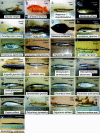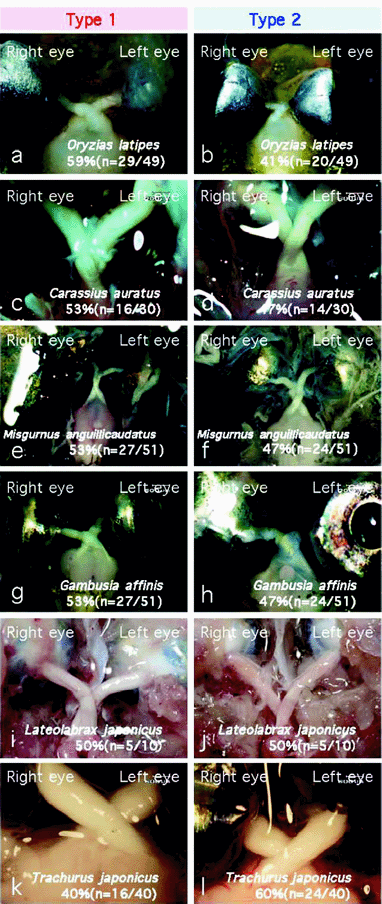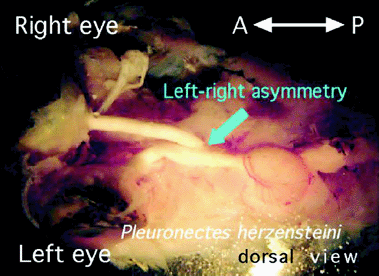Optic chiasm in the species of order Clupeiformes, family Clupeidae: optic chiasm of Spratelloides gracilis shows an opposite laterality to that of Etrumeus teres
- PMID: 19229672
- PMCID: PMC2661845
- DOI: 10.1080/13576500802628160
Optic chiasm in the species of order Clupeiformes, family Clupeidae: optic chiasm of Spratelloides gracilis shows an opposite laterality to that of Etrumeus teres
Abstract
In most teleost fishes, the optic nerves decussate completely as they project to the mesencephalic region. Examination of the decussation pattern of 25 species from 11 different orders in Pisces revealed that each species shows a specific chiasmic type. In 11 species out of the 25, laterality of the chiasmic pattern was not determined; in half of the individuals examined, the left optic nerve ran dorsally to the right optic nerve, while in the other half, the right optic nerve was dorsal. In eight other species the optic nerves from both eyes branched into several bundles at the chiasmic point, and intercalated to form a complicated decussation pattern. In the present study we report our findings that Spratelloides gracilis, of the order Clupeiformes, family Clupeidae, shows a particular laterality of decussation: the left optic nerve ran dorsally to the right (n=200/202). In contrast, Etrumeus teres, of the same order and family, had a strong preference of the opposite (complementary) chiasmic pattern to that of S. gracilis (n=59/59), revealing that these two species display opposite left-right optic chiasm patterning. As far as we investigated, other species of Clupeiformes have not shown left-right preference in the decussation pattern. We conclude that the opposite laterality of the optic chiasms of these two closely related species, S. gracilis and E. teres, enables investigation of species-specific laterality in fishes of symmetric shapes.
Figures









Similar articles
-
The organization of the fibers in the optic nerve of normal and tectum-less Rana pipiens.J Comp Neurol. 1983 Aug 10;218(3):282-96. doi: 10.1002/cne.902180305. J Comp Neurol. 1983. PMID: 6604077
-
Potential role of Pax-2 in retinal axon navigation through the chick optic nerve stalk and optic chiasm.J Neurobiol. 2004 Apr;59(1):8-23. doi: 10.1002/neu.20001. J Neurobiol. 2004. PMID: 15007823
-
Relationship between optic nerve length and interoptic angle in the prediction of optic chiasm location.Neurocirugia (Engl Ed). 2025 Jan-Feb;36(1):39-46. doi: 10.1016/j.neucie.2024.09.005. Epub 2024 Oct 2. Neurocirugia (Engl Ed). 2025. PMID: 39366484
-
Chiasm formation in man is fundamentally different from that in the mouse.Eye (Lond). 2007 Oct;21(10):1264-70. doi: 10.1038/sj.eye.6702839. Eye (Lond). 2007. PMID: 17914429 Review.
-
A comparison of eutherian and marsupial optic chiasms: a brief review.Rev Bras Biol. 1995 Dec;55 Suppl 1:1-10. Rev Bras Biol. 1995. PMID: 8729269 Review.
Cited by
-
Atypical Centriolar Composition Correlates with Internal Fertilization in Fish.Cells. 2022 Feb 22;11(5):758. doi: 10.3390/cells11050758. Cells. 2022. PMID: 35269380 Free PMC article. Review.
-
Bilateral visual projections exist in non-teleost bony fish and predate the emergence of tetrapods.Science. 2021 Apr 9;372(6538):150-156. doi: 10.1126/science.abe7790. Science. 2021. PMID: 33833117 Free PMC article.
-
An enigmatic translocation of the vertebrate primordial eye field.BMC Evol Biol. 2020 Oct 2;20(1):129. doi: 10.1186/s12862-020-01693-6. BMC Evol Biol. 2020. PMID: 33008334 Free PMC article. Review.
-
Characterization of optic nerve regeneration using transgenic zebrafish.Front Cell Neurosci. 2015 Apr 9;9:118. doi: 10.3389/fncel.2015.00118. eCollection 2015. Front Cell Neurosci. 2015. PMID: 25914619 Free PMC article.
-
Regrowth of transected retinal ganglion cell axons despite persistent astrogliosis in the lizard (Gallotia galloti).J Anat. 2013 Jul;223(1):22-37. doi: 10.1111/joa.12053. Epub 2013 May 9. J Anat. 2013. PMID: 23656528 Free PMC article.
References
-
- Aizawa H., Goto M., Sato T., Okamoto H. Temporally regulated asymmetric neurogenesis causes left–right difference in the zebrafish habenular structures. Developmental Cell. (2007);12:87–98. - PubMed
-
- Asanuma T., Matsuoka N. Phylogenetic relationships among seven fish species of the order Clupeiformes inferred from allozyme variation. Bulletin of the Faculty of Agriculture and Life Science, Hirosaki University. (2001);4:1–15.
-
- Baker G. E., Jeffery G. Distribution of uncrossed axons along the course of the optic nerve and chiasm of rodents. Journal of Comparative Neurology. (1989);289:455–61. - PubMed
-
- Bennett E. T. Observations on a collection of fishes from the Mauritius, with characters of new genera and species. Proceedings of the Zoological Society of London. (1831);1:126–128.
MeSH terms
LinkOut - more resources
Full Text Sources
Research Materials
Miscellaneous
